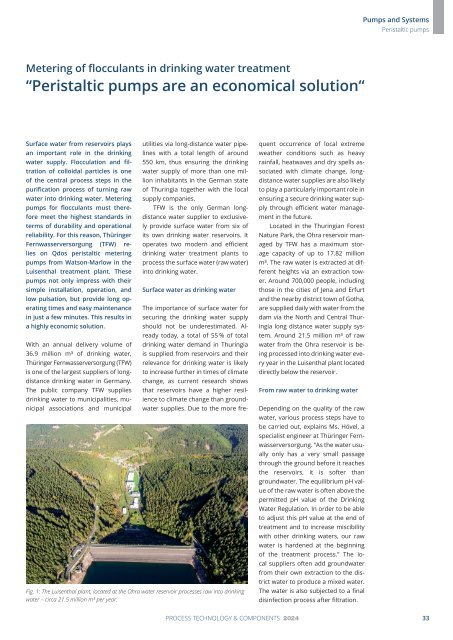PuK - Process Technology & Components 2024
A technical trade magazine with a history of more than 60 years.
A technical trade magazine with a history of more than 60 years.
You also want an ePaper? Increase the reach of your titles
YUMPU automatically turns print PDFs into web optimized ePapers that Google loves.
Pumps and Systems<br />
Peristaltic pumps<br />
Metering of flocculants in drinking water treatment<br />
“Peristaltic pumps are an economical solution“<br />
Surface water from reservoirs plays<br />
an important role in the drinking<br />
water supply. Flocculation and filtration<br />
of colloidal particles is one<br />
of the central process steps in the<br />
purification process of turning raw<br />
water into drinking water. Metering<br />
pumps for flocculants must therefore<br />
meet the highest standards in<br />
terms of durability and operational<br />
reliability. For this reason, Thüringer<br />
Fernwasserversorgung (TFW) relies<br />
on Qdos peristaltic metering<br />
pumps from Watson-Marlow in the<br />
Luisenthal treatment plant. These<br />
pumps not only impress with their<br />
simple installation, operation, and<br />
low pulsation, but provide long operating<br />
times and easy maintenance<br />
in just a few minutes. This results in<br />
a highly economic solution.<br />
With an annual delivery volume of<br />
36.9 million m³ of drinking water,<br />
Thüringer Fernwasserversorgung (TFW)<br />
is one of the largest suppliers of longdistance<br />
drinking water in Germany.<br />
The public company TFW supplies<br />
drinking water to municipalities, municipal<br />
associations and municipal<br />
utilities via long-distance water pipelines<br />
with a total length of around<br />
550 km, thus ensuring the drinking<br />
water supply of more than one million<br />
inhabitants in the German state<br />
of Thuringia together with the local<br />
supply companies.<br />
TFW is the only German longdistance<br />
water supplier to exclusively<br />
provide surface water from six of<br />
its own drinking water reservoirs. It<br />
operates two modern and efficient<br />
drinking water treatment plants to<br />
process the surface water (raw water)<br />
into drinking water.<br />
Surface water as drinking water<br />
The importance of surface water for<br />
securing the drinking water supply<br />
should not be underestimated. Already<br />
today, a total of 55 % of total<br />
drinking water demand in Thuringia<br />
is supplied from reservoirs and their<br />
relevance for drinking water is likely<br />
to increase further in times of climate<br />
change, as current research shows<br />
Fig. 1: The Luisenthal plant, located at the Ohra water reservoir processes raw into drinking<br />
water – circa 21.5 million m³ per year.<br />
that reservoirs have a higher resilience<br />
to climate change than groundwater<br />
supplies. Due to the more frequent<br />
occurrence of local extreme<br />
weather conditions such as heavy<br />
rainfall, heatwaves and dry spells associated<br />
with climate change, longdistance<br />
water supplies are also likely<br />
to play a particularly important role in<br />
ensuring a secure drinking water supply<br />
through efficient water management<br />
in the future.<br />
Located in the Thuringian Forest<br />
Nature Park, the Ohra reservoir managed<br />
by TFW has a maximum storage<br />
capacity of up to 17.82 million<br />
m³. The raw water is extracted at different<br />
heights via an extraction tower.<br />
Around 700,000 people, including<br />
those in the cities of Jena and Erfurt<br />
and the nearby district town of Gotha,<br />
are supplied daily with water from the<br />
dam via the North and Central Thuringia<br />
long distance water supply system.<br />
Around 21.5 million m³ of raw<br />
water from the Ohra reservoir is being<br />
processed into drinking water every<br />
year in the Luisenthal plant located<br />
directly below the reservoir.<br />
From raw water to drinking water<br />
Depending on the quality of the raw<br />
water, various process steps have to<br />
be carried out, explains Ms. Hövel, a<br />
specialist engineer at Thüringer Fernwasserversorgung.<br />
“As the water usually<br />
only has a very small passage<br />
through the ground before it reaches<br />
the reservoirs, it is softer than<br />
groundwater. The equilibrium pH value<br />
of the raw water is often above the<br />
permitted pH value of the Drinking<br />
Water Regulation. In order to be able<br />
to adjust this pH value at the end of<br />
treatment and to increase miscibility<br />
with other drinking waters, our raw<br />
water is hardened at the beginning<br />
of the treatment process.” The local<br />
suppliers often add groundwater<br />
from their own extraction to the district<br />
water to produce a mixed water.<br />
The water is also subjected to a final<br />
disinfection process after filtration.<br />
PROCESS TECHNOLOGY & COMPONENTS <strong>2024</strong><br />
33

















